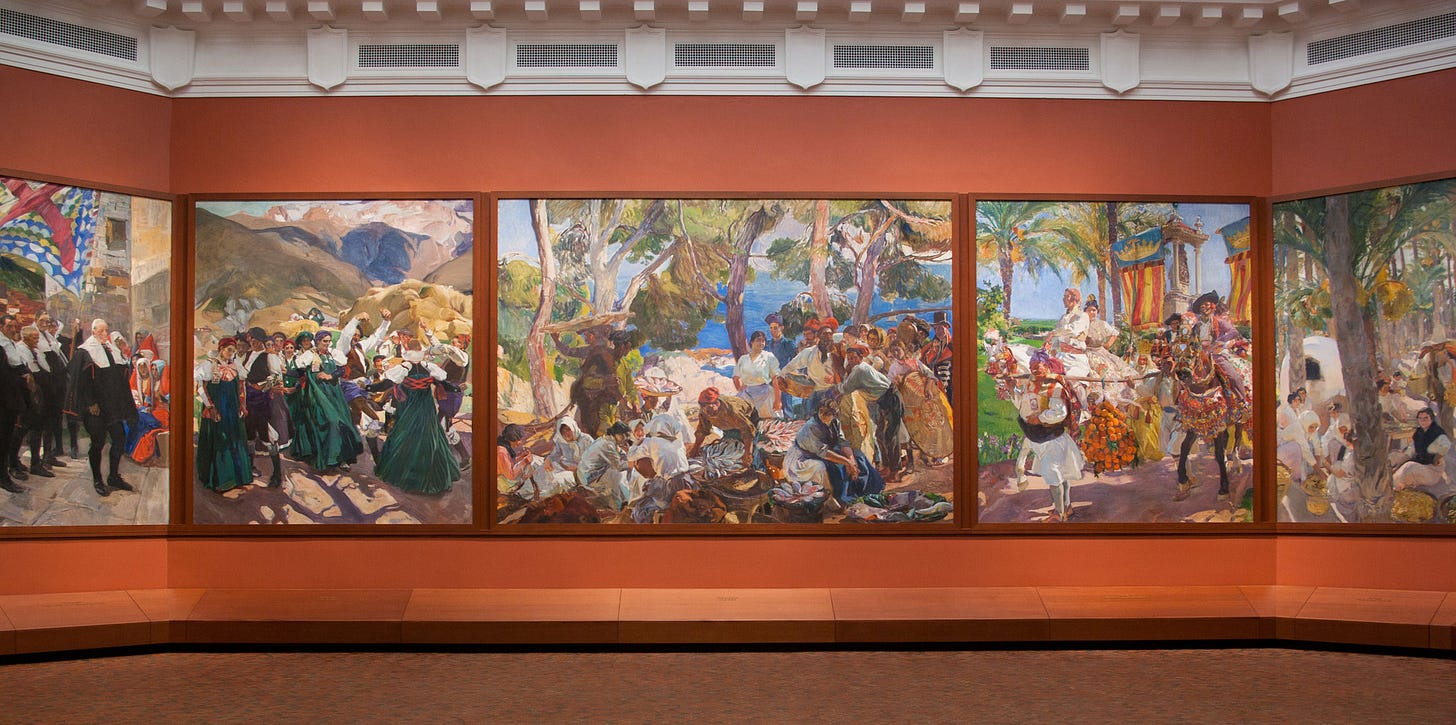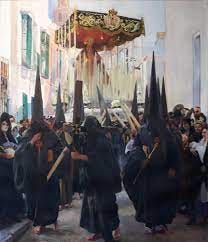Semana Santa in Spain
This week is Semana Santa. It is Holy Week in Spain. All over the country, but in particular in the south, reverent religious processions will take place during Easter Week in cities and towns all over Andalusia.
These processions will be forever connected with the great Spanish artist Joaquin Sorolla. Any honest assessment of Sorolla, who died one-hundred years ago this year, places him near the top of the list of all-time greatest Spanish artists. He should be thought of with Velazquez, Goya, and El Greco, based on the catalog of his work, along with his astonishing range, masterful technique, and the overall excellence of his paintings.
In the early 1900s Sorolla met a great American, Archer Huntington, the visionary founder of The Hispanic Society of America. The Hispanic Society Museum and Library is the most important center of Spanish art and culture outside of Spain. It is a stunning collection.
The ultimate product of the friendship between these two great men, Sorolla and Huntington, are the fourteen murals that hang in a special gallery of the Hispanic Society Museum in New York called The Vision of Spain. These murals are a monumental creation.
They are over two hundred feet in combined length and are about fourteen feet in height. Beyond their size, it is the ambitiousness of the subject-matter that is even more impressive: that is, the life and customs of virtually every corner of Spain in the early 1900s. Sorolla captures Spanish life at the moment in time just before it was forever changed by the invasion of the modern world.
In 1914 Sorolla completed the second of these murals, called Sevilla. Holy Week Penitents.
Seville is ground zero of Holy Week in Spain, and Sorolla’s great painting so well renders the unique mood of one of the dozens of these Religious Processions.
Adding to Sorolla’s evocative mural, I describe these processions in Seville in my book Holy Ghost…
“Seville, April 1925.
Seville was a wonder. It was a glorious, mysterious city bathed in soft colors and glowing light.
The three friends spent all day exploring the city’s barrios and backstreets, and they quickly concluded it was not like any place they knew.
After Columbus discovered the New World, Seville was the port of entry for ships returning from their journeys. Gold and other plunder gushed into Seville making it the world’s richest, most important city in the 16th century. Everywhere, around almost every street corner, there seemed to be another charming, tree-shaded plaza. Churches and palacios abounded. But what was most striking to them was the sensuality and mysteriousness of the city: the beautiful women shrouded in their mantillas, the smell of orange blossoms, the honey-colored buildings shading the narrow streets. It was intoxicating.
At just before midnight, in the minutes that separated Holy Thursday from Good Friday, Montse, her aunt and uncle, Xavi, and Jaime took their seats near the cathedral. They, along with tens of thousands of others from Seville, of all classes, were there to watch the most holy of the Semana Santa processions. There were throngs of people everywhere on the procession route that wound its way to the end point at the cathedral. The crowd was silent and somber as they waited for the first and oldest Hermandad to arrive.
Semana Santa was an ancient and sacred ritual in Seville. For a year leading up to Holy Week, nearly every one of the dozens and dozens of the city’s churches had a brotherhood which organized the procession of pasos. These gilded, ornate floats, depicting the passion of Jesus Christ and the suffering of His mother, were carried by costaleros who bore the weight of the massive structures on their strong shoulders. The floats were led by clergy and acolytes, sometimes accompanied by a band, and always surrounded by Nazarenos.
The Nazarenos were spectacularly unusual. They were penitents in procession. Dressed in uniform robes and wearing matching conical hats - capirotes - which covered their faces and had only small slits for their eyes. Historically, the capirote had been worn by criminals to mark them with shame; they had morphed to become a mask to create anonymity for the sinners seeking silent, anonymous forgiveness.
The first procession, El Silencio Brotherhood, which dated back to 1340, finally arrived. The costaleros shouldered their float which depicted Jesus carrying his cross, followed by another float of the suffering Mary. Surrounding both floats were Nazarenos robed in black robes and capirotes. The silence was sacred. It was humbling.
After the procession of the El Silencio came that of Jesus del Gran Poder. The quiet of the night was broken by the band playing their trumpets and pounding their drums. The rhythms of the music were hypnotic. The Nazerenos of this Brotherhood wore glistening black robes and capirotes.
The next procession to come was the most famous. La Hermandad de la Macarena. This Brotherhood was known for the immense strength of the costaleros who endured the fourteen-hour long procession from its home church to the cathedral and back. More importantly, the men carried a sacred statue of Mary, La Macarena. La Macarena sat on a float of white flowers and dozens of white candles, and She was surrounded by hundreds of the Brotherhood’s Nazarenos. Mary was painfully sorrowful. Her tears visibly pouring down her pallid face. The crowds came to see Her, to revere Her, and to seek Her intercession.
Along the way, and just before La Macarena reached the cathedral, a famous flamenco singer, Manuel Torre, began an extended Saeta. The Saeta (coming from the Latin word Sagitta, meaning arrow), was a highly emotional, spontaneous song sung in flamenco style. The Saeta channeled the Virgin’s pain and suffering; it truly seemed to be an arrow that pierced all who heard it. Many in the crowd began to weep.
The overall effect of seeing the processions for the first time was overwhelming. Xavi and Jaime mostly saw it as it was intended: a highly pious, if somewhat flamboyant Catholic display - something uniquely Andalusian.
For Montse however, it seemed bizarre and repulsive. It struck her as incongruously out of touch with the modern world.
As the sun began to rise the group made their way back to the Palacio, each separated in their own thoughts and impressions of what they had experienced.”
These processions go on today as they have for hundreds of years. Sacred, devout, and gloriously unconnected to the profanity of the modern world.





